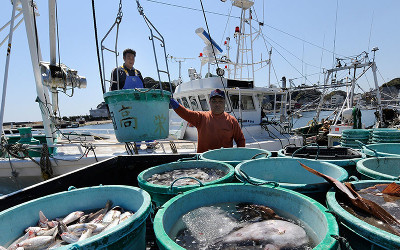AKIPRESS.COM -  Local fisheries have begun a debris cleanup near the Fukushima plant for the first time since the tsunami-triggered nuclear disaster. However a plan to start trial fishing next year may face a setback as a nearly-completed ice wall is failing to halt water contamination, RT reports.
Local fisheries have begun a debris cleanup near the Fukushima plant for the first time since the tsunami-triggered nuclear disaster. However a plan to start trial fishing next year may face a setback as a nearly-completed ice wall is failing to halt water contamination, RT reports.
On March 11, 2011, a magnitude-9 earthquake struck northeastern Japan at 2.46 pm, unleashing a deadly tsunami. Less than an hour after the earthquake, the first of many tsunami waves hit Japan's coastline. The tsunami waves reached heights of up to 39 meters at Miyako city and reached as far as 10 km ashore in Sendai, destroying everything in its wake. More than 15,000 people died.
At the Fukushima Daiichi Nuclear Power Plant, the tsunami caused a cooling system failure resulting in a nuclear meltdown and the release of radioactive materials. The waves forced the failure of electrical power and backup generators, leading the plant to lose its cooling capabilities. The retreating water sucked a vast amount of rubble into the depths of the Pacific Ocean, contaminating the traditional fishing grounds of the local companies.
Five years after the disaster a cleanup effort to remove the debris has finally been launched by collectives of local fishermen, who aim to start trial fishing expeditions within the area from 5 kilometers to 20 km off the wrecked plant.
On Monday, Soma-Futaba Fisheries Cooperative Association sent out 32 fishing boats to recover debris from the ocean floor. That fleet is focusing their efforts on the North side of the nuclear power plant. On Tuesday, the Iwaki City Fisheries Cooperative Association also sent in their fleet to help with the cleanup efforts of the southern side of the contaminated segment.
Once the debris is pulled out and delivered to shore, the unloading of the waste is handled by the industrial waste treatment company. The rubble is then sent to a temporary storage facility where after an inspection for radioactive reading, cleared waste is disposed of in an industrial manner. It is as of yet unclear how the contaminated waste will be treated.
The cleanup work of the seabed endorsed by the Fisheries Agency is scheduled to last at least until February of next year. Fishing on a trial basis can start as early as March.
The problem of water contamination however is just one of many surrounding the dismantling and decommissioning of the Fukushima plant debris which is estimated to take at least 40 years.
“We will continue to move forward with the decommissioning and contaminated water management in a transparent way, visible to the world, and will also share with the international community the lessons learned from this accident,” Hirotaka Ishihara, state minister of the cabinet office of Japan, said.
“We are also making ongoing efforts to ensure the safety of food produced in Japan,” he added. “Recognizing that many countries have already lifted restrictions on food imports from Japan, we encourage the international community to implement import policies based on scientific evidence.”
